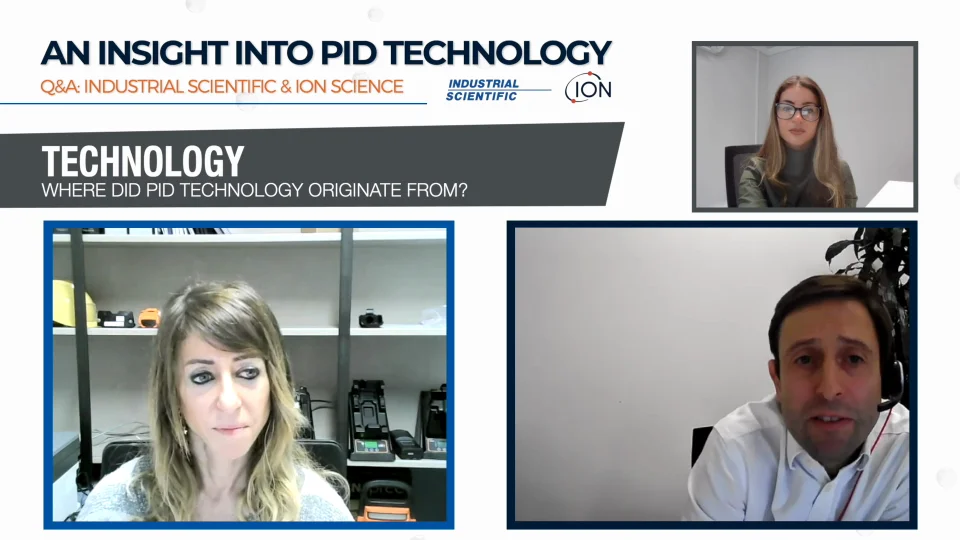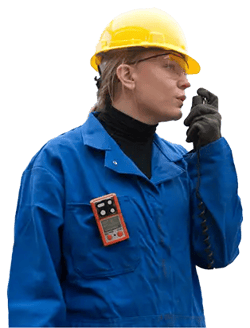 Industrial Scientific has spent over 20 years pioneering advancements in gas detection software, and the journey has taught us invaluable lessons. Through gathering and analyzing an immense dataset, we’re trusted by customers to keep their workers safe worldwide.
Industrial Scientific has spent over 20 years pioneering advancements in gas detection software, and the journey has taught us invaluable lessons. Through gathering and analyzing an immense dataset, we’re trusted by customers to keep their workers safe worldwide.
We sat down with our software product management team to explore the insights we've gained and the challenges our customers face, revealing how our rich data history informs fleet management and worker safety standards. Join us as Timothy Thompson, Michael Russin, and Adam Daniels discuss the evolution of our technology, the unique capabilities of our iNet platform, and how we're driving the future of industrial safety.
Industrial Scientific: What are some takeaways for Industrial Scientific after 20 years of providing gas detection software?
Timothy Thompson: What I found unique when coming to Industrial Scientific is that we've utilized the over 20 years of data to be able to provide an industry standard on how you should be operating your fleet, not only from a maintenance perspective, but also from a worker safety perspective. By knowing the industries each of our customers works in, we're able to tell what the baseline for how to run a safety program, expected as exposures or number of gas alarms, and even some cases jobs or functional areas in a way that can only be accomplished by having that much rich data over that period of time.
Michael Russin: I want to highlight the magnitude of the data we’ve helped customers collect over the years. Between 7.5 trillion individual data points and 150 million alarm events, it's indicative of the trust we have built with our customers and the longevity of our relationships with them.
The magnitude and longevity of our data sets is also representative of Industrial Scientific’s history of innovation. For decades, we have partnered with our customers to create new workflows—like fleet management and alarm mitigation—that improve safety outcomes at their worksites.
Industrial Scientific: Based on this data, what are the biggest challenges our customers face?
TT: I think one challenge, which is an opportunity, when discussing the new platform, is that our customers strive to tie safety data to the actual business processes impacting safety. Oftentimes, that data is in disparate locations and systems, requiring a lot of manual effort to access it. The question is, what insights can be gained from some of that information? There’s a big opportunity for us to improve our systems to help our customers do just that, and it’s something we’re currently working on. We can either pull in the information they have or push information to where we are subject matter experts, like Mike mentioned, with the 7.5 trillion data points.
Tying these pieces together gives our customers the ability to determine what is driving safety from a business performance perspective. This could involve business operations, such as a leak somewhere upstream in oil and gas, or a piece of equipment on the maintenance side causing issues. Tying that information together is really what they aspire to do, so they know where to focus their energy. That's the opportunity we have: to solve that pain.
Adam Daniels: One of the biggest challenges we also see is data latency. This is true for any gas detection provider. If a user, technician, operator, or frontline worker isn’t docking their instruments, then software doesn't know about it. That’s something we’re actively working to solve within iNet as well.
Industrial Scientific: So, let’s talk about iNet. What makes iNet unique?
MR: A customer can have a lot of growing pains when moving from simply checking a box for gas detection to investing in a more comprehensive gas detection program. They often need to change the actual hardware they’re using and retrain operators and management on how to use the devices and best leverage the data. What makes iNet unique is that our platform can meet customers where they are.
Within the iNet software, we have built cutting-edge capabilities like real-time monitoring for our most advanced customers but also include features available to all customers regardless of what device they are using that provide a data-rich experience when it comes to managing all the specific aspects of their fleet.
Industrial Scientific: Are there any insights based on customer behavior or data that current or future customers would be surprised to know?
TT: As part of improving our software, we had the opportunity to speak with many customers. We discussed various levels of safety and digital maturity curves, particularly with those who are more advanced in both areas. Their aspirations or attempts to apply analytics to the data in order to provide more targeted insights are notable. However, if you don't have the necessary data or your organizational culture isn't aligned, you may not be ready to implement such analytics.
Talking with those same customers, they described their journey of establishing a culture that supports data-driven organizational changes. This is something current customers, who may be less safety-conscious, could benefit from by hearing about the experiences and lessons learned from more advanced customers. This knowledge could help them reach a similar level of maturity.
AD: One of the insights I had myself during those calls was: no two exposures are the same. In the past, both competitors and Industrial Scientific have focused primarily on alarm counts. However, what we've learned from customers, and what unlocks new opportunities for iNet, is the need to understand the duration of alarms and whether they occurred in expected parts of the plant-location is vital to inform the full context of an exposure. Customers want more tools to drill down into the data and remove the noise.
My biggest insight for future customers is that not every alarm is equal. Organizations need capabilities to analyze data based on their own SOPs and standards to determine which exposures warrant investigations from an industrial hygienist perspective.
Industrial Scientific: It sounds like anyone using gas detection software would need to understand that data encompasses much more than just the "what." It's also about the "when," "why," and "how" behind every single alarm in their report.
TT: Yes, and the "who" is what they're trying to fill in.
Industrial Scientific: Looking forward, how do you envision the evolution of gas detection technology and its integration into broader safety systems?
MR: I believe one thing that many gas detection providers have overlooked in the past decade is that new features and technologies only succeed if they do not disrupt the operator's workflow. For many operators at customer sites, their workflow centers around day-to-day activities to support production and maintenance activities. Our job is to provide a device that will keep them safe but remain unobtrusive and not disrupt their daily jobs.
Looking ahead, the winning company in the gas detection space will be the one that can bring more data and insights to customers while minimizing workflow disruption for both operators and managers. Ultimately, no matter how valuable the data is, if it turns a two-minute daily task into a ten-minute one, customers will be hesitant to make that trade-off. That's how the market will evolve, and what the winner will look like.
AD: I envision a stronger partnership between safety and operations. Today, safety is often seen as the "fun police." However, what we'll start to see—not just in gas detection but with other site issues that safety departments monitor—is a shift toward departments that provide value to operations by reducing downtime. Whoever can integrate with minimum impact to workflows, as Mike mentioned, and help maintain or increase uptime will be successful. Instead of simply mandating frontline workers to carry a monitor, safety teams will be required to work with operations. The two functions will need to determine the most effective workflow, striking a better balance between safety and operations.
As safety standards continue to rise from a regulatory perspective, the sooner operations recognize the importance of giving safety a seat at the table, the better off the organization will be.
TT: I see a couple of things. First, the ability to apply analytics to gas detection data is an area where the industry is definitely moving. If you can provide industrial hygienists with data-driven insights that help them pitch process improvements and justify capital investments, it makes their job easier. Being able to do this will create a new wave of trust in the product you deliver, and you'll see a winner emerge in that space.
The other piece involves expanding beyond gas detection into industrial safety. As gas monitors become more compact and advanced, the work we've done at Industrial Scientific has helped reduce on-the-job deaths to the point where gas-related fatalities are not the leading cause of death in many industries we work with. I see industrial safety evolving to include data from other hazards, which is now more feasible thanks to the IoT landscape. A cohesive platform that includes all types of safety is where I see the industry moving in the future.
Interested in improving your safety measures with our insights? Get in touch with us to see how we can enhance your gas detection program.
Meet our Contributors
 Adam Daniels – Product Manager, SaaS
Adam Daniels – Product Manager, SaaS
Adam leverages nearly a decade of SaaS expertise to enhance EHS practices. He's driven by a passion for creating workflow-centric software that simplifies enterprise operations. Adam's forte is in developing SaaS applications for downstream oil & gas markets, and he's now channeling his efforts into connected safety solutions. His goal is to equip safety managers with reliable tools to ensure workforce protection. Adam's innovative approach and commitment to user-friendly products make him a pivotal contributor to the evolution of workplace safety.

Michael Russin – Senior Director, Software Product Management
Mike is the Senior Director of Software Product Management at Industrial Scientific. He previously led the hardware product management team and the scoping and development of our new area and personal monitoring platforms. Mike joined Industrial Scientific in 2020 as a Senior Product Manager for our iNet software platform.
 Timothy Thompson – Senior Product Manager, Software
Timothy Thompson – Senior Product Manager, Software
Timothy has over 10 years experience designing industrial software solutions designed at increasing productivity, reliability, and safety in the workplace. Having joined Industrial Scientific in 2022, Timothy’s background in predictive analytics has allowed him to focus energy on curating IoT data into industrial insights that supplement EHS workflows.




